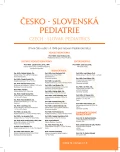The correlation between grade of adenoid hypertrophy verified by nasofiberendoscopy and grade of nasal obstruction objectivised by rhinomanometry
Authors:
J. Sojak 1,3; P. Ďurdík 2; R. Péčová 3,4
Authors‘ workplace:
Slovenská zdravotnícka univerzita v Bratislave, Lekárska fakulta Slovenskej zdravotníckej univerzity
Klinika otorinolaryngológie a chirurgie hlavy a krku, Ústredná vojenská nemocnica SNP – Fakultná
nemocnica, Ružomberok
1; Univerzita Komenského v Bratislave, Jesseniova lekárska fakulta v Martine (JLF UK), Klinika detí
a dorastu, Univerzitná nemocnica, Martin
2; Ústav patologickej fyziológie JLF UK, Martin
3; Martinské centrum pre biomedicínu JLF UK, Martin
4
Published in:
Čes-slov Pediat 2017; 72 (3): 164-169.
Category:
Original Papers
Overview
Background:
The aim of the study was to clarify correlation between the grade of adenoid hypertrophy objectivised by nasofiberendoscopy and the grade of nasal obstruction objectivised by rhinomanometry; to explicate changes between groups defined by the grade of mutual adenoid hypertrophy due to grade of nasal obstruction and due to parameters of nasal patency.
Methods:
Altogether 156 children (average age of 6.7 years and average height of 123 cm) were submitted to a nasal fiberoptic endoscopy; condition of nasopharynx and the grade of potential adenoid hypertrophy were determined, according to which the children were divided into groups. We also conducted active anterior rhinomanometry and assessed values of total transnasal inspiratory airflow (Fl.L+R) and total nasal resistance (ResL+R). We compared these values with reference parameters and assessed grade of nasal obstruction for all groups. Subsequently we statistically evaluated relations between groups defined by the grade of adenoids, grade of nasal obstruction, and parameters of nasal patency.
Results:
We confirmed positive correlation between the grade of adenoids and grade of nasal obstruction (p<0.0001), whilst higher grade of adenoids relates to higher grade of obstruction. We confirmed statistically significant differences between groups defined by adenoids’ grade due to grade of nasal obstruction (p<0.0001); thus between all particular groups with adenoids reciprocally, when groups with higher grade of adenoids suffer from higher grade of nasal obstruction more frequently. We confirmed significant differences between groups defined by adenoids’ grade due to Fl.L+R and ResL+R (p<0.0001), whereas due to higher grade of adenoids we observed decrease of Fl.L+R and increase of ResL+R.
Conclusions:
Rhinomanometry is diagnostic method, which helps us to define grade of nasal obstruction and derive the grade of adenoids, especially in patients who don´t tolerate the nasofiberendoscopy. It is optimal, if rhinomanometry is in advance complemented by nasofiberoendoscopy, in order to exclude another nasal cavity and nasopharyngeal pathologies. Rhinomanometry can help us to evaluate effect of therapy. Evaluation of clinical status and nasofiberendoscopy complemented by rhinomanometry can be considered as most effective and most objective diagnostic algorithm used in adenoids therapy.
Key words:
adenoids, nasal obstruction, nasal patency, airway resistance, rhinoendoscopy, rhinomanometry
Sources
1. Papaioannou G, Kambas I, Tsaoussoglou M, et al. Age-dependent changes in the size of adenotonsillar tissue in childhood: implications for sleep-disordered breathing. J Pediatr 2013; 162 (2): 269–274.
2. Rajeshwary A, Rai S, Somayaji G, et al. Bacteriology of symptomatic adenoids in children. N Am J Med Sci 2013; 5 (2): 113–118.
3. Zicari AM, Rugiano A, Ragusa G, et al. The evaluation of adenoid hypertrophy and obstruction grading based on rhinomanometry after nasal decongestant test in children. Eur Rev Med Pharmacol Sci 2013; 17 (21): 2962–2967.
4. Lertsburapa K, Schroeder JW Jr, Sullivan C. Assassment od adenoidal size: a comparison of lateral radiographic measurements, radiologist assessment, and nasal endoscopy. Int J Pediatr Otorhinolaryngol 2010; 74 (11): 1281–1285.
5. Kindermann CA, Roithmann R, Lubianca Neto JF. Sensitivity and specificity of nasal flexible fiberoptic endoscopy in the diagnosis of adenoid hypertrophy in children. Int J Pediatr Otorhinolaryngol 2008; 72 (1): 63–67.
6. McClay JE, Meyers AD. Adenoidectomy, 2013. http://emedicine.medscape.com/article/872216-overview.
7. Cassano P, Gelardi M, Cassano M, et al. Adenoid tissue rhinopharyngeal obstruction grading based on fiberendoscopic findings: a novel approach to therapeutic management. Int J Pediatr Otorhinolaryngol 2003; 67 (12): 1303–1309.
8. Příhodová I. Obstrukční spánková apnoe dětského věku. Čes-slov Pediat 2007; 62 (11): 631–663.
9. Jakubíková J, Lysý J, Staníková A, et al. Enuréza a adenotonzilárna hypertrofia. Čes-slov Pediat 2004; 59 (8): 420–421.
10. Dinis PB, Haider H, Gomes A. The effects of adenoid hypertrophy and subsequent adenoidectomy on pediatric nasal airway resistance. Am J Rhinol 1999; 13 : 363–369.
11. Zapletal A, Chalupová J. Nasal airflow and resistance measured by active anterior rhinomanometry in healthy children and adolescents. Pediatr Pulmonol 2002; 33 (3): 174–180.
12. Ko JH, Kuo TB, Lee GS. Effect of postural change on nasal airway and autonomic nervous system established by rhinomanometry and heart rate variability analysis. Am J Rhinol 2008; 22 (2): 59–65.
13. Momiyama Y. Nasal resistance in school children and students. Nihon Jibiinkoka Gakkai Kaiho 1989; 92 (2): 194–206.
Labels
Neonatology Paediatrics General practitioner for children and adolescentsArticle was published in
Czech-Slovak Pediatrics

2017 Issue 3
- What Effect Can Be Expected from Limosilactobacillus reuteri in Mucositis and Peri-Implantitis?
- The Importance of Limosilactobacillus reuteri in Administration to Diabetics with Gingivitis
Most read in this issue
- Patello-femoral disorders in children
- Legg-Calve-Perthes disease
- Pepsin in secretion from the upper respiratory tract as a marker of extraesophageal reflux in children
- RSV infection in late preterm infants
